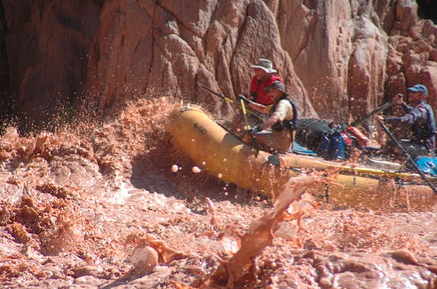Many thanks to Jeff Laird (Civil and Environmental Engineering at UC Davis) who presented his research, “Managing the Sediment Regime of the Colorado River,” on Wednesday, January 31, 2018.
In 1966 the Glen Canyon Dam was completed, dramatically changing the flow of the Colorado River. Like most dams, the Glen Canyon Dam traps sediment in downstream Lake Powell. Sediment is any of the naturally occurring sand, silt, mud, or organic material that is carried suspended in a river’s flow. Sediment flow is important for depositing sand to create sandbars in the active river channel, and to shape the banks and riparian habitats. Developing a sediment regime to have the optimal impact on riparian ecosystems and water resources management is critical but requires the juggling of many stakeholders’ interests and adhering to many different regulations.
The Shifting Sands of Sediment Management
Managing the sediment regime for the Colorado River is challenging, where many ecosystems and stakeholders have a say before the sand and
sediment accumulate in the delta at the mouth of Lake Mead. After the construction of the Glen Canyon Dam, most sediment comes from the Little
Colorado River—a reversal of historic levels. The confluence of these two rivers is downstream of Glen Canyon Dam, around river mile 61.7 and is where 90% of the overall sediment in the river 4 comes in. In the historical regime the main stem used to carry 90% of the sediment while the little Colorado only brought in around 10%. The above image shows just how dramatic the difference between the Little Colorado (on the left, muddy and red) and the clear Colorado River that flows from the Glen Canyon Dam.

The Grand Canyon Protection Act of 1992 was put into place to “Protect, mitigate adverse impacts to, and improve the values for which Grand Canyon National Park and Glen Canyon National Recreation Area were established, including, but not limited to natural and cultural resources and visitor use” and this led to the creation of two management programs. One of the management programs provides a 20-year framework to continue the adaptive management, or a structured, iterative process of robust decision making in the face of uncertainty, with an aim to reducing uncertainty over time via system monitoring. An adaptive management program to determine operations at Glen Canyon Dam incorporate evidence from scientific experiments and studies.
Many different objectives must to be considered in the management of the Glen Canyon Dam and the Colorado River. The sediment specific goals listed in the management plan exist under the “Restore Natural Processes.” Specifically, the plan sets out to increase and retain fine sediment volume, area, and distribution in the Glen, Marble, and Grand Canyon reaches above the elevation of the average base flow for ecological, cultural, and recreational purposes. An example of recreational purposes would be sandbar creation for boater habitat. Below, boaters are pictured during a high flow experiment.
The environmental and recreational impacts of these changes to sediment deposition are being addressed in Colorado River management through the release of high flow experiments, large-volume, short-duration scheduled releases designed to mimic
seasonal flooding of the former river flow. While high flow experiments were first promoted in 1995, the first tests in were not until 1996, and then later in 2004 and 2008. A high flow experimental release of approximately 42,000 cubic feet per second for 24 hours. This is compared to the usual variable daily flow designed to maximize energy production through hydropower of around 1,000 to 25,000 cubic feet per second. The goal of the high-flow experiment is to move sand stored in the river channel and redeposit it to rebuild eroded sandbars and beaches in Grand Canyon National Park.

After high flow experiments in 2012, 2013, 2014, and 2016 the current management plan has high flow experiments that would be implemented as soon as they are triggered, based on sand mass balance estimates from Paria River sediment inputs during the spring and fall accounting periods, with the aim to rebuild sandbars. These Sediment-Triggered Spring high flow experiments will begin in 2020. Further, there are proactive Spring high flow experiments that will be triggered in years with high annual water volume. These future high flow experiments will have a longer duration than previous ones, ranging up to ten days.
Optimal Management is Clear as Mud but an Adaptive Approach is Good
Has the Glen Canyon Dam management met its objective “Increased and retained fine sediment volume, area, and distribution in the Glen, Marble, and Grand Canyon reaches above the elevation of the average base flow for ecological, cultural, and recreational purposes”? Has it “Restor[ed] natural processes”? The adaptive management plan of the Glen Canyon Dam and Colorado river has not turned back time and brought the river back to its conditions before the creation of the Glen Canyon Dam. However, the management and scientists have learned a lot in how to maintain a healthy river that serves many purposes. Commitment to adaptive management is a success in its own right, leading to scientifically informed policies.
References
Laird, Jeff. “Managing the Sediment Regime of the Colorado River” Presentation to ECL 290/GEO 230 at UC Davis. January 31, 2018.
